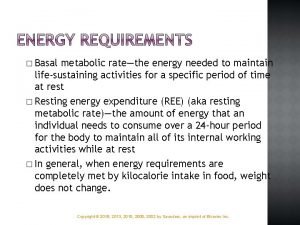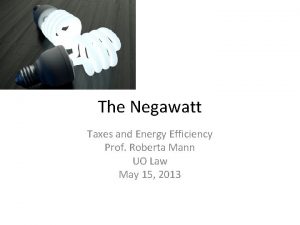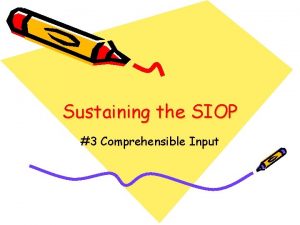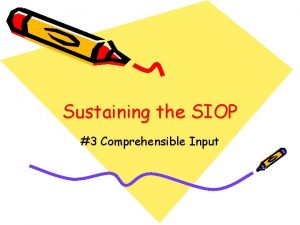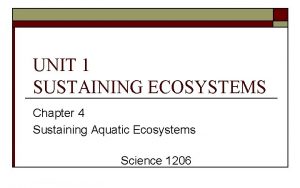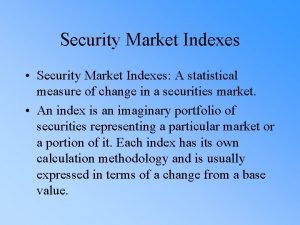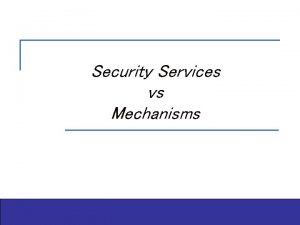A NEGAWATT MARKET FOR SUSTAINING ENERGY SERVICES SECURITY













- Slides: 13

A NEGAWATT MARKET FOR SUSTAINING ENERGY SERVICES SECURITY IN THE UK Reem Yusuf and Yael Parag Socio-Technical approach for the Security of Energy Services (STESS) Project Funded by the EU FP 7 Framework Environmental Change Institute (ECI), University of Oxford Interdisciplinary Center (IDC) Herzliya 6 th International Scientific Conference on Energy and Climate Change Athens, Greece - October 10, 2013

ENERGY SERVICES SECURITY VS ENERGY SECURITY Demand Socio-Techno-Economic Vs Techno-Economic Supply Energy Services Security (ESS): “the extent to which the population in a defined area (country or region) can have access to affordably and competitively priced, environmentally-acceptable energy services of adequate quality” (Jansen, 2009: 7). The security of energy services presents a more appropriate term than energy security, as the ultimate energy policy goal – and challenge - is providing consumers with adequate and reliable energy services.

§ SOCIO-TECHNO-ECONOMIC APPROACH (STE) + MULTILEVEL-PERSPECTIVE (MLP) ENERGY SERVICES SECURITY (ESS) STE can help overcome possible barriers to energy conservation, energy efficiency , and carbon emission reduction mechanisms; § MLP allows for a comprehensive analysis through applying a systemic approach taking into account energy providers, consumers and their intermediaries; § The two approaches tackle the financial and technological barriers that are challenging but they also manage the complexities of consumption behavior; § Here, we focus our attention on the role of energy consumers, those within the residential and commercial sectors as perceived by the UK government through its most recent energy and climate change policies. § We then analyze consumers’ interlocking and potentially transformative roles by way of their potential involvement in new energy markets and initiatives

AN INTEGRATED DEMAND-SIDE APPROACH FOR NEGAWATT MARKETS Energy Efficiency Demand Response Negawatt Market Behavioral Change Self Generation & ICT Economically incentivizing energy users to change their consumption behavior is a way for facilitating the Integrated Demand-side system (above) and the notion of sufficiency. This can be achieved at least-cost through creating an energy savings market or the socalled Negawatt market.

WHAT IS A NEGAWATT MARKET?

A NEGAWATT MARKET… A WIN-WIN SOLUTION § treats a unit of saved energy as a commodity with a discounted price tradable between consumers, utilities, and generators; § enables creating new incentives for reducing demand for electricity; § allows for further flexibility in generating off-grid energy and offgrid energy services which grant households more freedom to pick and choose which energy service to save and when to do so; § acts as an enabling mechanism for creating new markets and niches needed to prevent further technological lock-ins and opportunities particularly necessary during the current economic downturn.

ADVANTAGES OF A NEGAWATT MARKET § involves the entire supply chain plus consumers from all sectors including households; § transforms energy users from being merely passive consumers to active participants; § provides incentive for continuous reduction in energy consumption rather than incentives for technology adoption; § helps promote off grid and decentralized energy generation; § fosters public engagement in electricity generation and in the sector as a whole

WHY A NEGAWATT MARKET FOR THE UK? § § Projected electricity demand increase, due to electrification of transport and heating; § UK’s Continental Shelf reserves depleting leading to further reliance on import; § the need for large investments in low carbon generation to reduce carbon emissions; § reduce at least 34% of GHG emissions below its 1999 baseline by 2020 and 80% by 2050 with the power sector to be largely decarbonized by 2030; § Under UK’s Renewables Roadmap, 15% of total energy consumed is expected to be generated from renewable sources by 2020 § Electricity prices are projected to rise based on some global natural gas price increase scenarios, high costs of Carbon Capture and Storage, cost of renewable energy § Approximately GBP 110 billion of investment is needed in the electricity sector alone by 2020 Decline in capacity: Fifth of existing power plants (coal, oil, nuclear) are to cease operation by 2020 (total capacity loss of 19. 1 GW) as they are either reaching the end of their lifecycle or because they do not comply with environmental regulations set by the Industrial Emissions Directive. Further closures are expected by 2023;

UK ELECTRICITY MARKET REFORM, 2011 • Begin at 15. 70/t. CO 2 in 2013 rising to 70/t. CO 2 in 2030 • Based on EU ETS • Put a fair price on carbon • Incentivize investors in lowcarbon generation Carbon Emission Reduction • Set at 450 g CO 2/KWh • Limit new coal plants's emissions • Through an auction based market-wide capacity mechanism Carbon Price Floor (CPF) Emission Performance Standard (EPS) Capacity Mechanism Feed-in-Tariff Contract for Difference (Fi. T-Cf. D) Energy Supply Security • Reduce investor risk • Stabilize revenue from low carbon generation

ASSOCIATED CHALLENGES § UK’s total generation capacity is 90. 2 GW out of which 20% is of a capacity margin. With an estimated energy deficit of approximately 19. 1 GW (around 1/5 of the total installed capacity) due to power plant closure, the country’s de-rated capacity margin will drop to less than 5% by 2020 § While the introduced set of mechanisms can assist in overcoming some energy supply challenges, it disregards energy demand reduction as a way of achieving the government’s targets at least-cost and in the short-term. § There is no transparent market in savings, although it is believed that there have been bilateral trades between suppliers, as well as sales of insulation measures to suppliers from the managing agent for Government funded programs” (Eyre et al, 2009: 435). The policy mechanism is designed to influence investment in energy efficiency technology, rather than the effective use of that technology once installed.

SOLUTION: COMBINED DEMAND-SIDE & SUPPLY SIDE FOR ENERGY SERVICES SECURITY § The security of energy services requires integrating both supply-side as well as demand-side approaches that when combined allow for greater involvement by engaging intermediary actors capable of supplying energy services. § While a Negawatt market can significantly reduce CO 2 emissions and reduce electricity costs, it can also open opportunities for greater energy services security, reduce needed investment in infrastructure and power stations, which can all assist the UK in meeting its carbon emissions reduction and energy security targets in the short term and in a costeffective way

PROPOSED ELECTRICITY MARKET FOR THE UK Electricity Market Supply Capacity Market Generation Capacity Fi. T Cf. D Non-Generation (DSR, Storage, Connection) Demand Carbon Price Floor EPS Negawatt Market Personal Carbon Trade Energy Efficiency Demand Response Behavior Change

Thank you
 The energy needed to maintain life-sustaining activities
The energy needed to maintain life-sustaining activities Security security security
Security security security Market leader challenger follower nicher examples
Market leader challenger follower nicher examples Segmentation targeting and positioning
Segmentation targeting and positioning Sustaining engineering definition
Sustaining engineering definition Environmental science sustaining your world
Environmental science sustaining your world 3 aspects of value-oriented retail strategy
3 aspects of value-oriented retail strategy Building and sustaining relationships in retailing pdf
Building and sustaining relationships in retailing pdf Creating and sustaining competitive advantage
Creating and sustaining competitive advantage Building and sustaining relationships in retailing
Building and sustaining relationships in retailing Sustaining commitment
Sustaining commitment Causes of extinction
Causes of extinction Sustaining biodiversity
Sustaining biodiversity Substances that nourish the body
Substances that nourish the body
